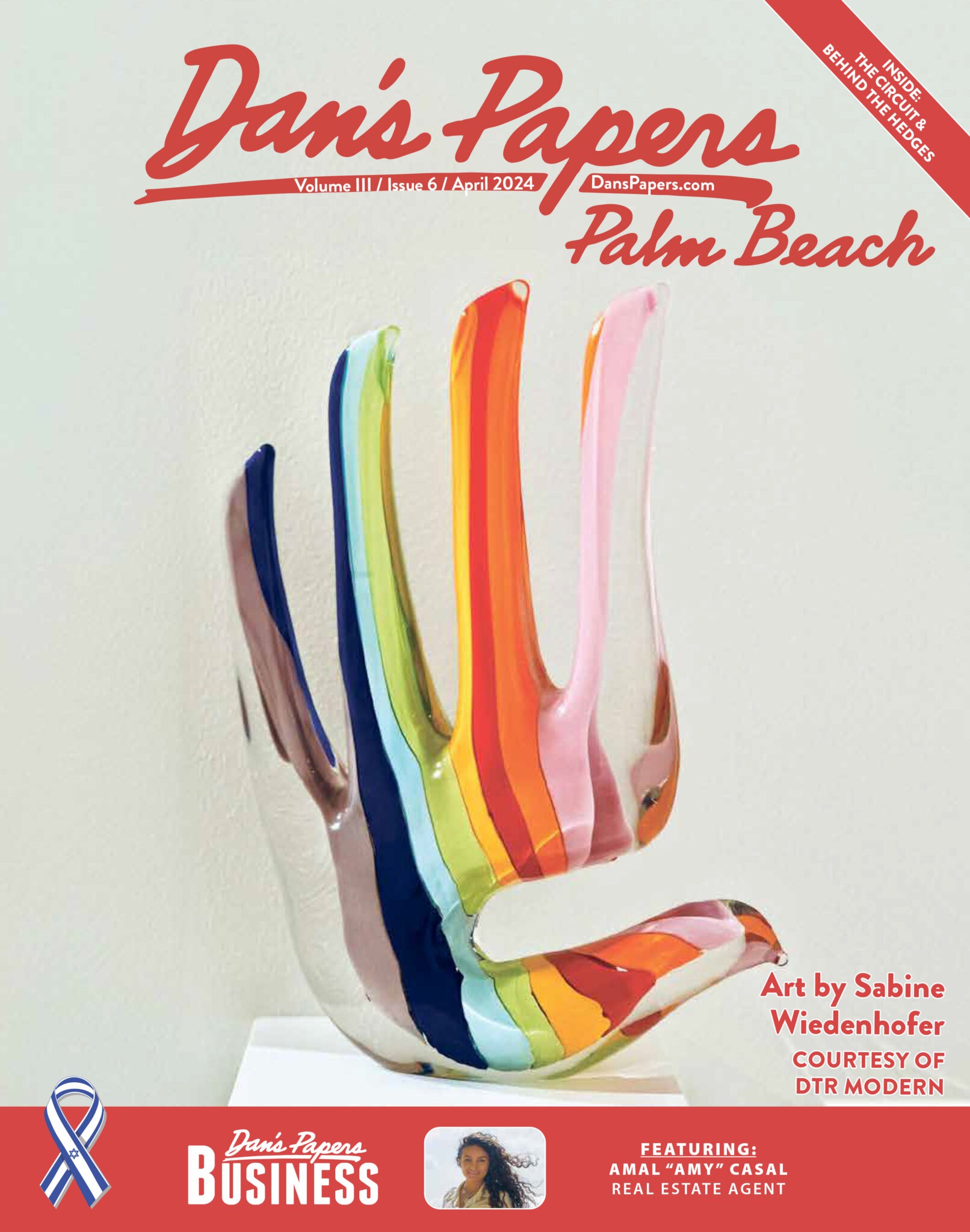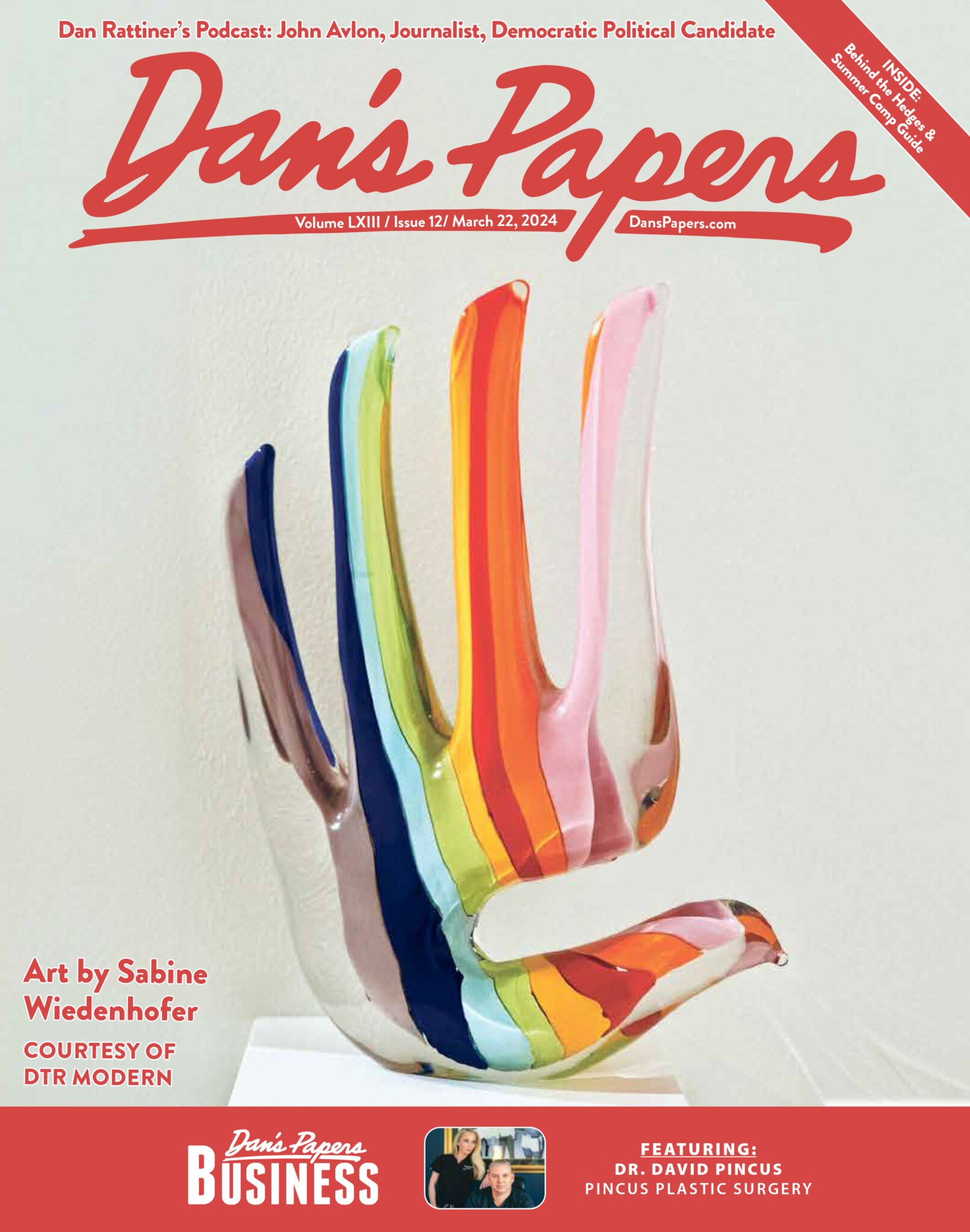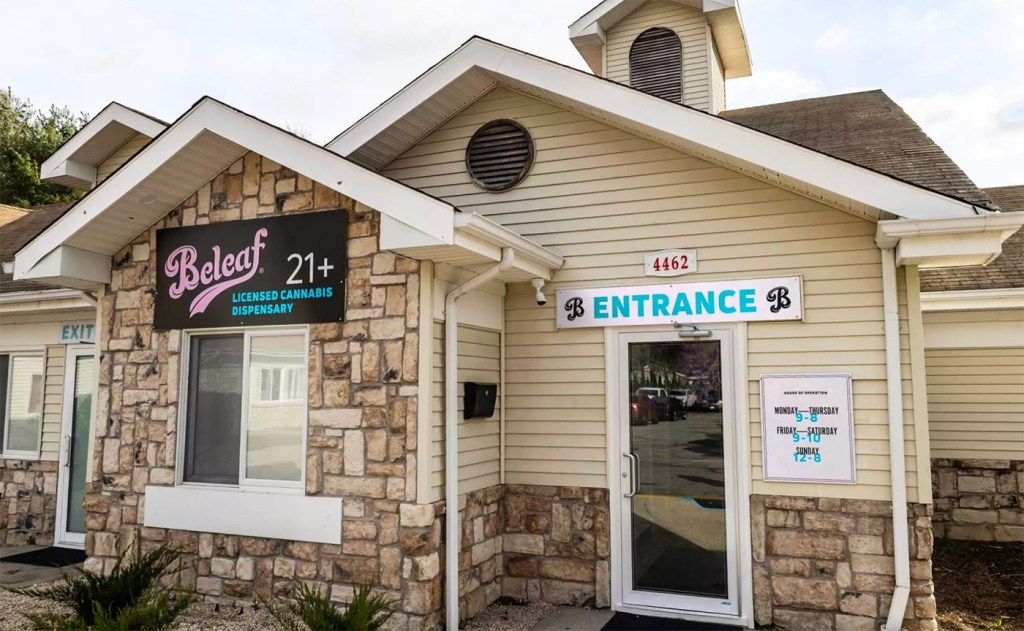Dan's Cover Artist Sabine Wiedenhofer Talks Glass Sculpture & More
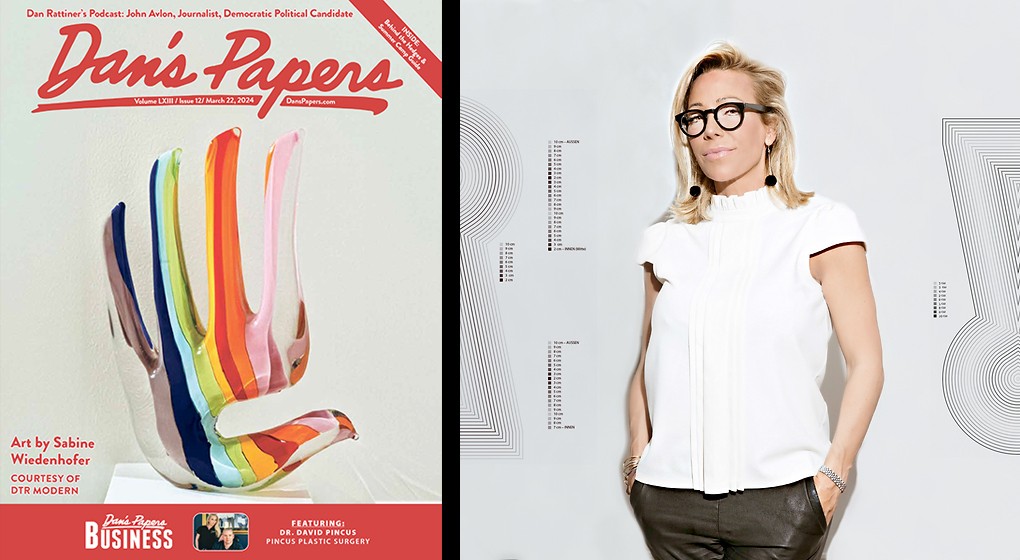
The featured cover sculpture, “Give Peace a Hand” by Sabine Wiedenhofer, comes to us from DTR Modern Gallery and marks the Vienna-born artist’s Dan’s Papers cover debut. Based in Palm Beach, NYC and Boston, DTR Modern gave us the scoop on Wiedenhofer’s glass sculpture work, her evolution as an artist and the upcoming exhibition at the Venice Biennale.
A Conversation About Sabine Wiedenhofer
How is Wiedenhofer’s glass sculpture work representative of the artistic voice and themes explored in her contemporary art portfolio?
The choice of glass as a medium for artistic expression in Sabine Wiedenhofer’s work is motivated by the multi-dimensionality as much as the poetic nature of the material. In its very essence, glass lives by an inherent dichotomy, aligning paradoxical — and even mutually exclusive — characteristics such as fragility and strength, opacity and transparency, presence and absence.
Years of training are required to forge the idiosyncratic matter into meaningful compositions, in a constant ballet between its molten-viscose and solid-unrelenting form. The resulting tension accordingly is what defines the intrigue of glass as a creative tool to think with. Rather than a static medium, glass lives by its very own whims — a certain caprice to be taken into considerations for a meaningful use of the vitreous matter for works of art.
Against this background, Wiedenhofer’s glass sculptures harness the potential of the material in order to convey a range of themes she addresses in her works. Concerned with the precarious status quo of a world in turmoil, Wiedenhofer has discovered glass as an eloquent language to communicate her creative vision through the poignant semantics of a century-old substance.
The broad range of topics reflected in her words — ranging from displacement and mass migration to conflict and war — thus converge in her sculptural oeuvre in glass, as the medium affords a multiplicity of expressive gestures that are ultimately mirrored in the very nature of its shape-shifting personality.
From TriBeCa to Give Peace a Hand or Alea Iacta Est, the individual works come alive by virtue of their material self-awareness. With her intuitive understanding of her matter of choice, Wiedenhofer embraces glass in a unique way, thereby forging a subtle dialogue between medium and message which operate in a mutually enlightening way.
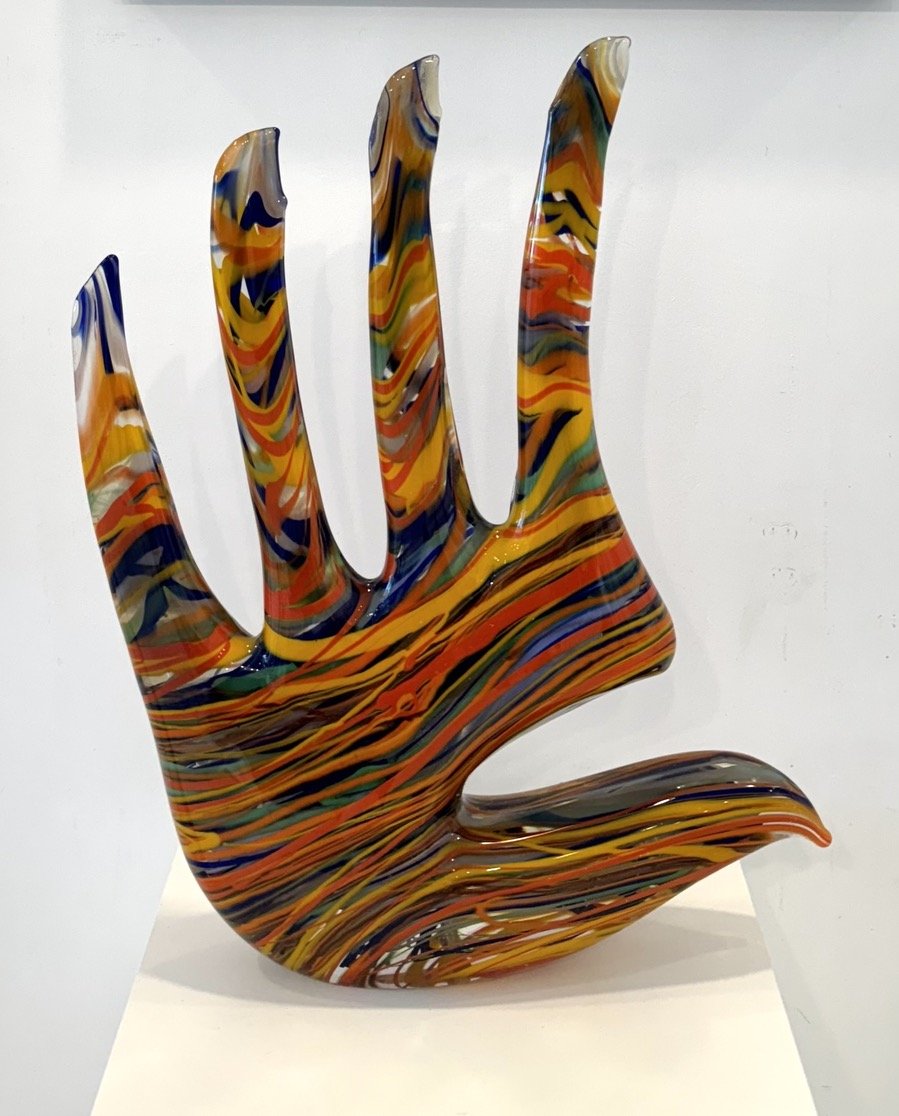
How has Wiedenhofer evolved as an artist and sculptor throughout her career?
Over the course of years, Wiedenhofer has gradually formulated a strong artistic philosophy rooted in an understanding of art as an instrument and tool to communicate without words. Her message proceeds from a vision of togetherness in a world that is ever more fractured and divided. As a global language, art has the power to transcend boundaries, to weave tapestries of mutual encounter beyond cultural, political or social trenches.
Through her genre-spanning approach to artistic creation — from painting to sculpture and mixed media — she endeavors to further explore the themes that constitute the core of her research. While her oeuvre thus straddles various expressive modes, the individual works yet all bear her handwriting, united by an aesthetics of the respective topics rather than one singular style. As her career continues to unfold, it is curiosity and playfulness, that characterize her oeuvre, in a nod to a general attitude towards life that as a shimmer of hope underlies her creations.
When did DTR Modern’s relationship with Wiedenhofer begin, and at what stage of her career was she at that time?
The collaboration between DTR Modern and Wiedenhofer began when Ted Vassilev came across the first version of TriBeCa in Vienna, a work now in the Mortimer Grubman Collection. Upon their initial encounter, Wiedenhofer’s career was at a critical point of consolidating her as a contemporary artist whose research started to form into a strong vision. The use of glass for sculpture thereby marked a decisive turning point as the material unlocked new forms of expression that allowed for a further extension as well as refinement of Wiedenhofer’s body of works.
How has her status in the art world evolved since DTR Modern began representing her?
Since the representation by DTR Modern, Wiedenhofer’s status in the art world has been confirmed through various exhibitions, shows as well as commissions that all allowed her to push the boundaries of her creative practice. Today, more than ever, a network of support proves vital for an artistic career to take off whereby a sustained and continued conversation lies at the heart of a strong oeuvre.
Since art never happens — and never has happened — in a vacuum, but a setting of exchange, discussion and debate, relationships such as the collaboration with DTR Modern constitute a pivotal anchor for a grounding of discourses and reflections.
What is one of the most impressive accolades of Wiedenhofer’s career so far?
For Wiedenhofer, success as an artist is not primordially tied to or measured in terms of exhibitions or shows, awards or accolades that might figure on a CV but rather the actual impact her works have on the respective audience. In view of the social cause that underlies her work, her aim is to enter in a meaningful dialogue with the viewer as their emotional response is what confirms her understanding of art, namely a form of nonverbal communication via the universal language of emotions that is spoken globally.
What will Wiedenhofer showcase at the Venice Biennale, and what does her inclusion in this exhibition mean for her career?
In line with this year’s motto of the Venice Biennale Foreigners Everywhere the works included in the exhibition of Glasstress will showcase Wiedenhofer’s most recent creations. Present in two venues — the Arsenal Nord and the Berengo Exhbition Space in Murano — the artist will stage a meta-discourse across the Lagoon with respect to the use of glass on the one hand, the integration of water on the other.
The inclusion in the show alongside other artist who have worked in the medium — such as Ai Weiwei, Thomas Schütte or Tony Cragg — places her in a long tradition of visionary minds who have equally turned to glass as a powerful medium to address urgent questions. In addition to that, the context of the Venice Biennale promises to lend yet another framework to her sculptural installation, as Alea Iacta Est may be read as a meta-comment on the topic raised in the main show.
Would you like to share any info about Wiedenhofer’s art or exhibitions at the DTR Modern Galleries in NYC, Palm Beach, Nantucket, Washington, D.C. or Boston?
“Give Peace a Hand“ is the motto that gave birth to Wiedenhofer’s eponymous sculpture whose shape is reminiscent of a hand turning into a dove and vice versa. Executed in Murano glass, the work lives by the material poetry of a century-old tradition where the fragility of the medium recalls the precariouus status quo of a world in turmoil while the range of colours invoke hope for a better version of planet Earth. On display at the DTR Gallery in Palm Beach since March 2024, the “Give Peace a Hand” will also be unveiled as a public sculpture in autumn 2024. Installed on a Nazi-built bridge in an Austrian town, the six-meter-high monument to peace and humanity will act as a reminder of what is at stake as a global society where giving peace a hand reveals to be the sine qua non for a new togetherness.
To shop Sabine Wiedenhofer’s art, visit dtrmodern.com/sabine-wiedenhofer.
